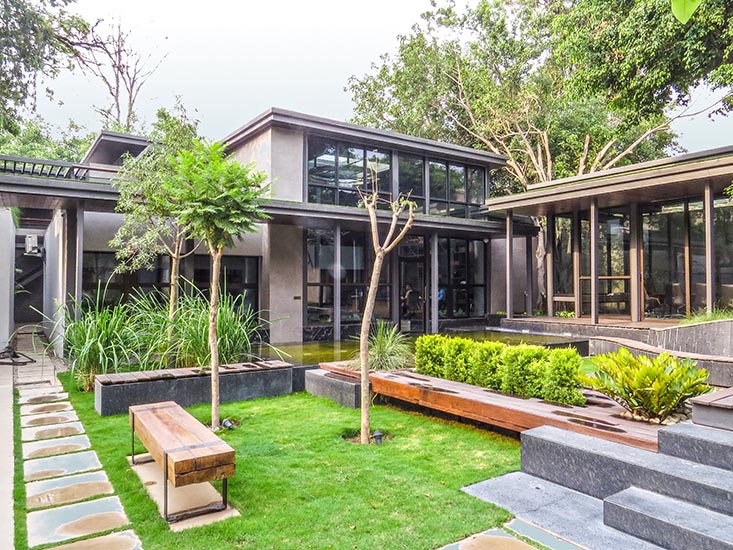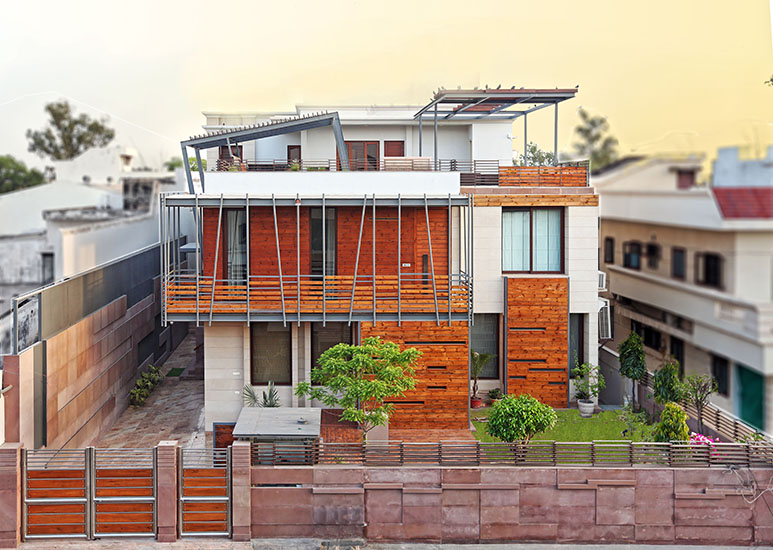![RM[9] | Image © Architecture Paradigm](https://hawmagazine.com/wp-content/uploads/2013/02/RM9.jpg)
Architectural Group: Architecture Paradigm
Client: Mr. Ramesh Makam
Project Area (Built Up): 5000 sq. ft
Project Type: Residential
Project Location: Bangalore, India
Estimated Cost: 110 Lakhs
Image Copyright/Courtesy: Architecture Paradigm
News Source: From the office of Architecture Paradigm
Our intent was to explore notion of a shelter, which could be as basic as a roof floating over head to shade us against the tropical sun but the need for privacy and conditions pertaining to seasonal changes, dust, insects etc cannot be ignored in our context. The house became an exploration of these generic concerns and expressing possibilities in lifestyles in these gated communities, which demands a strong, connect with the outdoors considering the climate of Bangalore. The brief described a house with four bedrooms of around 5000 sq.ft and it had to follow principles of vaastu. The need of addressing these principles and the formal requirement of a sloped roof was seen as a means to establish a new identity rather than seeing them as restrictions.
The program was seen as volume which was blocked in two levels and placed as bar along the southwestern corner of the site with the creation of large open space along the north and the east. The rectangular volume is perforated along the eastern edge to initiate a dialogue with the open space. The open spaces are allowed to permeate through these openings. This results in a diagram that expresses a dissolved edge along the east blurring the boundaries between the inside and the outside.
This approach also helped us to organize the program to achieve different degrees of privacy, while lending a seamless experience and retaining the identities of the program, built and the unbuilt. These spaces are connected by a spine along the north south axis. The subtracted spaces, seen as private spaces and are moved to the upper levels with potential to visually explore the low rise landscape at higher levels.
The need for slope as a part of the brief and our own interest to explore this familiar idiom in the south of India became the starting point to modulate this volume. The slope was considered from the south to the north and this aspect reiterated the length of the volume. The choice was based on climatic considerations and clients interest in vaastu.
The roof was tilted along the diagonal to create northeast as the lowest and south west as the highest point. This was subtly folded along the south east and northwest to create a more workable volume within. The footprint informs the roof which in turn responds to the alternating pattern of built and unbuilt, here the roof was subtracted or folded down to create openings above the courts. This results in a roof which is seen as an augmented terrain which can be accessed at the first floor and one can continue moving on to the second floor along the slope.
Program like the living room, dining are organized along the eastern edge of the house where they open out into the expanse of garden. Private spaces such as the bedrooms are organized along the western edge except at the higher level where one of the children’s rooms is placed in the south eastern corner. Master bedroom at the lower level opens out a landscaped internal court yard.
Dining is a double height space unifying the upper and lower levels.
![RM[6] | Image © Architecture Paradigm RM[6] | Image © Architecture Paradigm](http://www.howarchitectworks.com/wp-content/uploads/2013/02/RM6.jpg) A small family cum home theater is located at the upper level which opens on to terrace which is a result of the folded geometry. This space lends access to the folding and splitting sloped roof which can be seen as augmented terrain complimenting the distant hills. The roof terrain is perforated with circular openings, to bring in natural light into the courts and also create the effect of being under the canopy of tree. The idea of perforation is carried on to the vertical surfaces to establish a sense of continuum and to break the harsh sun and allow for wind movement. The large sliding doors are designed along the eastern edge such that when they are opened house becomes a pavilion integrating with the landscape.
A small family cum home theater is located at the upper level which opens on to terrace which is a result of the folded geometry. This space lends access to the folding and splitting sloped roof which can be seen as augmented terrain complimenting the distant hills. The roof terrain is perforated with circular openings, to bring in natural light into the courts and also create the effect of being under the canopy of tree. The idea of perforation is carried on to the vertical surfaces to establish a sense of continuum and to break the harsh sun and allow for wind movement. The large sliding doors are designed along the eastern edge such that when they are opened house becomes a pavilion integrating with the landscape.
Landscaping strategies which included elements like Water body, hard and soft landscaping, and pavilion for parking are used to further articulate the open spaces bring in a sense of scale and orientation. The roof of the parking pavilion is used to house solar cells to generate electricity for the house. Strategies like rainwater harvesting where the filtered water is collected and used for drinking as well, solar energy is used for both water heating and production of electricity and use of locally available materials, renders this project as a realistic attempt to address energy crisis in our times.
When one walks in and around the house, spaces fold and unfold which is akin to waking through or around a large origami. There is also a sense of familiarity and change with respect to form and scale where the slopes feel familiar, so do the courts but the way it has been tackled expresses the sense of new. Owing to the complexity of the roof a framed RCC structure is adopted and this also provides for the possibility of using the terrace as a sloped terrain unlike traditional roofs. Different textures in the form of natural materials like stone, wood mixed with terracotta tile, glass and plastered surfaces along with the landscape come together to create an experience. The essence of the house lies in the fact that the created spaces allow for the family to come together celebrate and also connect with the environment, here architecture becomes a vessel to engender fond memories.

![RM[9] | Image © Architecture Paradigm RM[9] | Image © Architecture Paradigm](http://www.howarchitectworks.com/wp-content/uploads/2013/02/RM9.jpg)
![RM[5] | Image © Architecture Paradigm RM[5] | Image © Architecture Paradigm](http://www.howarchitectworks.com/wp-content/uploads/2013/02/RM5.jpg)
![RM[15] | Image © Architecture Paradigm RM[15] | Image © Architecture Paradigm](http://www.howarchitectworks.com/wp-content/uploads/2013/02/RM15.jpg)
![RM[4] | Image © Architecture Paradigm RM[4] | Image © Architecture Paradigm](http://www.howarchitectworks.com/wp-content/uploads/2013/02/RM4.jpg)
![RM[3] | Image © Architecture Paradigm RM[3] | Image © Architecture Paradigm](http://www.howarchitectworks.com/wp-content/uploads/2013/02/RM3.jpg)
![RM[1] | Image © Architecture Paradigm RM[1] | Image © Architecture Paradigm](http://www.howarchitectworks.com/wp-content/uploads/2013/02/RM1.jpg)
![RM[7] | Image © Architecture Paradigm RM[7] | Image © Architecture Paradigm](http://www.howarchitectworks.com/wp-content/uploads/2013/02/RM7.jpg)
![RM[12] | Image © Architecture Paradigm RM[12] | Image © Architecture Paradigm](http://www.howarchitectworks.com/wp-content/uploads/2013/02/RM12.jpg)
![RM[14] | Image © Architecture Paradigm RM[14] | Image © Architecture Paradigm](http://www.howarchitectworks.com/wp-content/uploads/2013/02/RM14.jpg)
![RM[8] | Image © Architecture Paradigm RM[8] | Image © Architecture Paradigm](http://www.howarchitectworks.com/wp-content/uploads/2013/02/RM8.jpg)
![RM[11] | Image © Architecture Paradigm RM[11] | Image © Architecture Paradigm](http://www.howarchitectworks.com/wp-content/uploads/2013/02/RM11.jpg)
![RM[10] | Image © Architecture Paradigm RM[10] | Image © Architecture Paradigm](http://www.howarchitectworks.com/wp-content/uploads/2013/02/RM10.jpg)
![RM[13] | Image © Architecture Paradigm RM[13] | Image © Architecture Paradigm](http://www.howarchitectworks.com/wp-content/uploads/2013/02/RM13.jpg)





